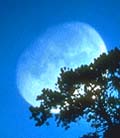Read The Ocean
Tides, Moon, and the Moveable Feast.
by Ed Jaworowski
 Locating fish in the ocean constitutes the angler's first order of business, surpassing tackle choice, fly selection or technique in importance. Fly anglers in particular, because of the limited effective range of their tackle, need all the help they can get to improve their odds in a seemingly endless sea, shore based anglers even more so. Several facts compound an already difficult chore. Locating fish in the ocean constitutes the angler's first order of business, surpassing tackle choice, fly selection or technique in importance. Fly anglers in particular, because of the limited effective range of their tackle, need all the help they can get to improve their odds in a seemingly endless sea, shore based anglers even more so. Several facts compound an already difficult chore.
 First, most ocean game fish don't have homes. Their movements are largely determined by the movement of the food supply and tides. Second, their habits are greatly affected by the physical makeup of the areas in which they feed. This primer will remove some of the mysteries of tides and structure. Reading the ocean, like reading a trout stream, is an indispensable skill and a first requirement for the salt water angler. First, most ocean game fish don't have homes. Their movements are largely determined by the movement of the food supply and tides. Second, their habits are greatly affected by the physical makeup of the areas in which they feed. This primer will remove some of the mysteries of tides and structure. Reading the ocean, like reading a trout stream, is an indispensable skill and a first requirement for the salt water angler.
 Tides represent the single biggest difference between fresh and salt water fishing. Though game fish may temporarily take up residence around structure---inlets, seawalls, rock jetties, sand bars and the like---they will invariably move on with the next tide, following migrating food forms which also obey tidal influences. Any angler who hopes to score with an consistency in the salt must have at least a rudimentary knowledge of the way tides work. However subtle, tidal movements establish what amount to the equivalent of fresh water rivers. Here are some of the basics and suggestions on how to fit it all into your fishing. Tides represent the single biggest difference between fresh and salt water fishing. Though game fish may temporarily take up residence around structure---inlets, seawalls, rock jetties, sand bars and the like---they will invariably move on with the next tide, following migrating food forms which also obey tidal influences. Any angler who hopes to score with an consistency in the salt must have at least a rudimentary knowledge of the way tides work. However subtle, tidal movements establish what amount to the equivalent of fresh water rivers. Here are some of the basics and suggestions on how to fit it all into your fishing.
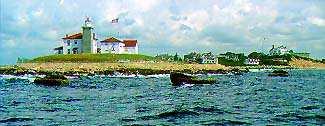
 The gravitational pulls of the moon and, to a lesser degree, the sun, cause ocean waters to move, building higher in some areas while getting lower in others. As a rule, a section of coast will experience two high tides and two low tides in each 24-25 hour period. A low will follow a high every six to six and one-half hours. Each day the highs and lows will therefore occur about an hour later than the previous day. This also means that at a given time and day each week, the tide will be nearly the exact opposite from what it was the previous week. If you had good fishing on the incoming tide on Saturday morning at daybreak, remember that you will have the opposite tide the following Saturday at the same time. The gravitational pulls of the moon and, to a lesser degree, the sun, cause ocean waters to move, building higher in some areas while getting lower in others. As a rule, a section of coast will experience two high tides and two low tides in each 24-25 hour period. A low will follow a high every six to six and one-half hours. Each day the highs and lows will therefore occur about an hour later than the previous day. This also means that at a given time and day each week, the tide will be nearly the exact opposite from what it was the previous week. If you had good fishing on the incoming tide on Saturday morning at daybreak, remember that you will have the opposite tide the following Saturday at the same time.
 During different times of the month tides also vary. When the new moon (the darkest time of the month) and the full moon occur, expect the highest highs and lowest lows. Such tides are called "spring tides". It means during the six hours of tidal flow between the highs and lows you will note faster flows and stronger pulls. During the first and last quarters of the moon the tides are weaker, current flows slower and differences less great---lower highs and higher lows. Such tides are called "neap (or nip) tides". During different times of the month tides also vary. When the new moon (the darkest time of the month) and the full moon occur, expect the highest highs and lowest lows. Such tides are called "spring tides". It means during the six hours of tidal flow between the highs and lows you will note faster flows and stronger pulls. During the first and last quarters of the moon the tides are weaker, current flows slower and differences less great---lower highs and higher lows. Such tides are called "neap (or nip) tides".
 Here's a typical scenario. If the new moon occurs on the 1st of the month and the full moon about two weeks later, on the 15th, you will experience the highest and lowest tides and strongest pulls at those times of the month (stronger over the full moon). During the week preceding each of those phenomena tides wax stronger, waning each successive day following. During the weeks of the first and last quarters (approximately the 8th and 22nd) the tides will be gentler. Also, on any given day, if a high tide occurs at 6:00 a.m., expect the next low around noon and the next high 6-7:00 p.m. Here's a typical scenario. If the new moon occurs on the 1st of the month and the full moon about two weeks later, on the 15th, you will experience the highest and lowest tides and strongest pulls at those times of the month (stronger over the full moon). During the week preceding each of those phenomena tides wax stronger, waning each successive day following. During the weeks of the first and last quarters (approximately the 8th and 22nd) the tides will be gentler. Also, on any given day, if a high tide occurs at 6:00 a.m., expect the next low around noon and the next high 6-7:00 p.m.
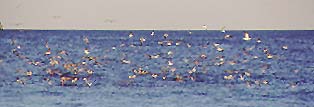
 The change of water level from high to low will also vary with geographic locale. Consider the Atlantic coast. On Florida flats, only a few inches may separate low tide from high tide, particularly during the neap tide periods. On the Bay of Fundy, Nova Scotia, on the other hand, there may be more than a 25' difference; the flooding tide comes in so quickly that a man walking rapidly can't outpace it. Mid- Atlantic coastal states commonly show four to six foot tidal variations. As a rule, tide variations are less closer to the equator. The change of water level from high to low will also vary with geographic locale. Consider the Atlantic coast. On Florida flats, only a few inches may separate low tide from high tide, particularly during the neap tide periods. On the Bay of Fundy, Nova Scotia, on the other hand, there may be more than a 25' difference; the flooding tide comes in so quickly that a man walking rapidly can't outpace it. Mid- Atlantic coastal states commonly show four to six foot tidal variations. As a rule, tide variations are less closer to the equator.
 Tide tables are approximations based upon a couple of dozen factors, in addition to time of month, time of day and moon phase, and changes in some of these may alter the predicted times. Other contributing factors affecting fish behavior are wind, weather, light intensity, bait availability, barometric pressure, currents. The wind is one of the strongest. A strong and persistent wind following the waves can make a high tide occur much earlier than predicted and reach much higher onto the shore. Obviously, when blowing against the tide, it can have the opposite results, actually holding the ocean back. I've seen 150 yds. of a New Jersey beach exposed when it should have been under a few feet of water, totally because of a strong northwest wind. Tide tables are approximations based upon a couple of dozen factors, in addition to time of month, time of day and moon phase, and changes in some of these may alter the predicted times. Other contributing factors affecting fish behavior are wind, weather, light intensity, bait availability, barometric pressure, currents. The wind is one of the strongest. A strong and persistent wind following the waves can make a high tide occur much earlier than predicted and reach much higher onto the shore. Obviously, when blowing against the tide, it can have the opposite results, actually holding the ocean back. I've seen 150 yds. of a New Jersey beach exposed when it should have been under a few feet of water, totally because of a strong northwest wind.
 Changes in atmospheric pressure will affect the water. Low barometric pressure will allow the surf to rise higher and develop more violent wave action. We've all seen what happens to the ocean during a hurricane, a period of very low barometric pressure. Changes in atmospheric pressure will affect the water. Low barometric pressure will allow the surf to rise higher and develop more violent wave action. We've all seen what happens to the ocean during a hurricane, a period of very low barometric pressure.
 All this data may seem confusing to the newcomer to salt water fishing but it's really no more so than learning about fresh water insect hatches or differences in fly dressings. On the other hand, knowledge of tides can be more important than either of those concerns; if you fish where there is no water or can't get the feeding grounds, you're not apt to catch many fish. All this data may seem confusing to the newcomer to salt water fishing but it's really no more so than learning about fresh water insect hatches or differences in fly dressings. On the other hand, knowledge of tides can be more important than either of those concerns; if you fish where there is no water or can't get the feeding grounds, you're not apt to catch many fish.
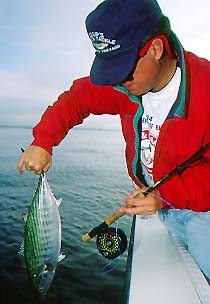
 Here is a random list of additional ideas for the angler to consider. Here is a random list of additional ideas for the angler to consider.
-When you plan to fish an area, consider how the tide will affect the water there. During times of strong tidal flow, bait will be caught and forced to collect in rips around jetties and inlets; the bait can't swim against the flow.
 -During spring tides, high waters will flood grass beds in the bays and tear loose a lot of eel grass and other vegetation. The effect is less during neap tide periods. Grass build up is generally also greater the closer you fish to an inlet. -During spring tides, high waters will flood grass beds in the bays and tear loose a lot of eel grass and other vegetation. The effect is less during neap tide periods. Grass build up is generally also greater the closer you fish to an inlet.
 -One change of tide can dirty the water or can clear a surf, by bringing or removing grass or cloudy water. -One change of tide can dirty the water or can clear a surf, by bringing or removing grass or cloudy water.
 -Usually, more white water tends to develop when the tide is dropping. It tends to disappear on a rising tide. -Usually, more white water tends to develop when the tide is dropping. It tends to disappear on a rising tide.
 -My experience has been that tides are less a factor when fishing farther from shore. Inshore, moving water, whether incoming or outgoing, is nearly always superior to the static water you get at flood or ebb tide. A moving tide tends to concentrate bait; static water allows it to disperse. -My experience has been that tides are less a factor when fishing farther from shore. Inshore, moving water, whether incoming or outgoing, is nearly always superior to the static water you get at flood or ebb tide. A moving tide tends to concentrate bait; static water allows it to disperse.
 -Great changes in water temperature can effect fishing. If deeper offshore water is cooler, a strong tide may move it inshore, displacing the shallower warmer water and turn fish off. -Great changes in water temperature can effect fishing. If deeper offshore water is cooler, a strong tide may move it inshore, displacing the shallower warmer water and turn fish off.
 -Know the contour of the beach you fish. When the tide drops, game fish will make every effort to get out to deeper water rather than risk being cut off by a sand bar. If the bar is a hundred yards from shore, the fish will be out of range at low tide. If you can't wade to the bar, plan on fishing the area closer to shore at higher tide, when the fish can get over the bar. -Know the contour of the beach you fish. When the tide drops, game fish will make every effort to get out to deeper water rather than risk being cut off by a sand bar. If the bar is a hundred yards from shore, the fish will be out of range at low tide. If you can't wade to the bar, plan on fishing the area closer to shore at higher tide, when the fish can get over the bar.
 -Note that the times of the highs and lows along the coast will be approximately the same along the beach for many miles. Back on the bays, estuaries and creeks, however, tides may be two, three or four hours different. Tide tables will tell you how to make the necessary adjustments. Get a tide table for the area you are considering fishing. Bait and tackle shops will carry them. You can also consult local newspapers. Learn how to read the tables and consider them a basic part of your equipment. -Note that the times of the highs and lows along the coast will be approximately the same along the beach for many miles. Back on the bays, estuaries and creeks, however, tides may be two, three or four hours different. Tide tables will tell you how to make the necessary adjustments. Get a tide table for the area you are considering fishing. Bait and tackle shops will carry them. You can also consult local newspapers. Learn how to read the tables and consider them a basic part of your equipment.
 As with tides, learning to read structure will increase your odds dramatically. Even when the arrival of bait and favorable tides indicate the likelihood of game fish in the area, narrowing the possible spots demands some skill in recognizing structure and understanding why some spots are more likely to be productive than others. As with tides, learning to read structure will increase your odds dramatically. Even when the arrival of bait and favorable tides indicate the likelihood of game fish in the area, narrowing the possible spots demands some skill in recognizing structure and understanding why some spots are more likely to be productive than others.
 Like fresh water bass, stripers gravitate to rocks, weeds, bars. Bluefish often feed close to underwater lumps, ridges or wrecks. Snook hide among mangroves, weakfish seek out bottom depressions or jetties and false albacore like rips and strong flows. All these game fish regularly position themselves where structure will concentrate food, making it easy to locate, ambush or trap. Just what constitutes structure? Basically any bottom formation or contour like a sand bar or drop-off, rocks, wrecks, bridge and pier pilings, weeds, even waves. Structure may be natural or artificial, temporary or permanent. Like fresh water bass, stripers gravitate to rocks, weeds, bars. Bluefish often feed close to underwater lumps, ridges or wrecks. Snook hide among mangroves, weakfish seek out bottom depressions or jetties and false albacore like rips and strong flows. All these game fish regularly position themselves where structure will concentrate food, making it easy to locate, ambush or trap. Just what constitutes structure? Basically any bottom formation or contour like a sand bar or drop-off, rocks, wrecks, bridge and pier pilings, weeds, even waves. Structure may be natural or artificial, temporary or permanent.
  One of the most obvious forms of structure is the jetty or groin, usually a man-made, rocky finger jutting out from the beach. Jetties cause waves to break, loosening shellfish and organisms on which the fish feed. They also provide places for forage fish to hide as well as causing and directing currents. The biggest mistake you can make when fishing from jetties is to cast out and away. Nearly all feeding takes place close to and among the rocks. Cast parallel to the rocks and smack your offerings down right in the foaming water. Rubber headed Siliclone flies are especially deadly in this situation. One of the most obvious forms of structure is the jetty or groin, usually a man-made, rocky finger jutting out from the beach. Jetties cause waves to break, loosening shellfish and organisms on which the fish feed. They also provide places for forage fish to hide as well as causing and directing currents. The biggest mistake you can make when fishing from jetties is to cast out and away. Nearly all feeding takes place close to and among the rocks. Cast parallel to the rocks and smack your offerings down right in the foaming water. Rubber headed Siliclone flies are especially deadly in this situation.
 All kinds of pilings also give shelter to bait. Some are best fished from a boat and most produce best at night, so scout out your spots at day. It's amazing how bold fish become in the dark, swimming around boat docks and harbors they would never approach in daylight. Look for older pilings, as new piers and docks haven't yet developed incrustations that provide food for the chain. White perch, weakfish and stripers particularly like docks, piers and bridges. At night, they lie on the edge of the shadows and assault bait attracted to lights shining on the water. You are very apt to see and hear surface activity then. I've taken scores of small stripers all around the piers and terminals in New York Harbor, the East River and the Brooklyn waterfront! All kinds of pilings also give shelter to bait. Some are best fished from a boat and most produce best at night, so scout out your spots at day. It's amazing how bold fish become in the dark, swimming around boat docks and harbors they would never approach in daylight. Look for older pilings, as new piers and docks haven't yet developed incrustations that provide food for the chain. White perch, weakfish and stripers particularly like docks, piers and bridges. At night, they lie on the edge of the shadows and assault bait attracted to lights shining on the water. You are very apt to see and hear surface activity then. I've taken scores of small stripers all around the piers and terminals in New York Harbor, the East River and the Brooklyn waterfront!
 Many back bays are marked by sod banks, grass covered islands and cut-outs of land laced by narrow streams. Fish take up position any place a smaller flow dumps water into a larger area. If you can walk the sod banks (some are mucky and nearly impossible to walk), stay back from the edge. Not only might it give way, you could spook the fish, which like to hang under the overhang and rush out to snatch bait. A small boat, even a car-topper with a small outboard is adequate to fish among the sod banks in many areas. Nautical charts of the areas you plan to fish provide invaluable assistance in locating channels, holes and dropoffs and bars. Many back bays are marked by sod banks, grass covered islands and cut-outs of land laced by narrow streams. Fish take up position any place a smaller flow dumps water into a larger area. If you can walk the sod banks (some are mucky and nearly impossible to walk), stay back from the edge. Not only might it give way, you could spook the fish, which like to hang under the overhang and rush out to snatch bait. A small boat, even a car-topper with a small outboard is adequate to fish among the sod banks in many areas. Nautical charts of the areas you plan to fish provide invaluable assistance in locating channels, holes and dropoffs and bars.
 Some ocean front structure is obvious. Reading other forms requires more experience. Look first at the contour of the beach. Is it pretty straight, north-south, or scalloped out with indentations and cuts? Straighter beaches generally don't attract bait so well. They have fewer points to obstruct wave flow and form holes and pockets, thus fewer ambush points. Storms and heavy wave action may create new holes and sand bars---or destroy them. Routinely check out and explore the beaches you want to fish. They can change in short order. Also take note of the slope of the beach. Flatter beaches have less bottom structure, hence less cover for fish. Steeper beaches allow bait to move closer to the shore. Some ocean front structure is obvious. Reading other forms requires more experience. Look first at the contour of the beach. Is it pretty straight, north-south, or scalloped out with indentations and cuts? Straighter beaches generally don't attract bait so well. They have fewer points to obstruct wave flow and form holes and pockets, thus fewer ambush points. Storms and heavy wave action may create new holes and sand bars---or destroy them. Routinely check out and explore the beaches you want to fish. They can change in short order. Also take note of the slope of the beach. Flatter beaches have less bottom structure, hence less cover for fish. Steeper beaches allow bait to move closer to the shore.
  Bars running parallel to the beach commonly draw fish, yet some provide great fishing on the inshore side, while others are fishless. The difference usually depends on breaks in the bar. If you see white water breaking over a bar within 100 or 200 yards of the shore, forming a deep trough close to the beach, check to see if there are any cuts (marked by darker colored water) through which fish can get back to the safety of deeper water. Without such cuts, fish have little opportunity to get over the bar, usually only for the brief periods of high water and then generally only at night. On the other hand, fish will stay and feed in deep troughs close to the beach right through low water, so long as they have the opportunity to get back beyond the bar through a cut or channel. Bars running parallel to the beach commonly draw fish, yet some provide great fishing on the inshore side, while others are fishless. The difference usually depends on breaks in the bar. If you see white water breaking over a bar within 100 or 200 yards of the shore, forming a deep trough close to the beach, check to see if there are any cuts (marked by darker colored water) through which fish can get back to the safety of deeper water. Without such cuts, fish have little opportunity to get over the bar, usually only for the brief periods of high water and then generally only at night. On the other hand, fish will stay and feed in deep troughs close to the beach right through low water, so long as they have the opportunity to get back beyond the bar through a cut or channel.
 Thick weed masses also serve as structure. They form slack pockets in the current where bait can hide and fish can feed, just like weed beds in a smallmouth stream. A drift over a bay or ocean bottom with an electronic depth finder/fish locator is a real eye opener. Fish will register in the tiniest of pockets or holes, more so if they can hide behind vegetation anchored to the bottom. However, even clear bottoms can hide fish in depressions; waves and currents flow over them. Thick weed masses also serve as structure. They form slack pockets in the current where bait can hide and fish can feed, just like weed beds in a smallmouth stream. A drift over a bay or ocean bottom with an electronic depth finder/fish locator is a real eye opener. Fish will register in the tiniest of pockets or holes, more so if they can hide behind vegetation anchored to the bottom. However, even clear bottoms can hide fish in depressions; waves and currents flow over them.
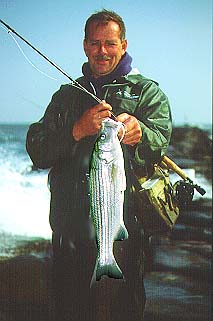  Finally, waves themselves sometimes represent a form of structure. Surf turbulence can conceal game fish stalking forage. An understanding of how wave action works shows how this can be so. As a wave moves toward the shore, the water particles swirl down and back up in a circular path, equal in diameter to the height of the wave. For example, as a three foot wave moves toward the shore, the water particles near the surface go down and around in a three foot clockwise pattern, nearly returning to their starting position as the wave itself rolls along. Sand particles, grass and other suspended matter are also moved around by this turbulence. A striped bass can readily move into striking range concealed by this mass of confusion and visual disturbance. Incidentally, you can estimate the depth of water on a bar over which a wave breaks. Normally a wave breaks when it reaches a depth equal to its own height up to one and a half times its height. Thus, a four-foot wave will break when it runs into bottom interference four to six feet down. The most effective way to fish a turbulent surf is to let your fly wash around on a semi-slack line, simulating the naturals which lose much their ability to swim in the strong currents. Finally, waves themselves sometimes represent a form of structure. Surf turbulence can conceal game fish stalking forage. An understanding of how wave action works shows how this can be so. As a wave moves toward the shore, the water particles swirl down and back up in a circular path, equal in diameter to the height of the wave. For example, as a three foot wave moves toward the shore, the water particles near the surface go down and around in a three foot clockwise pattern, nearly returning to their starting position as the wave itself rolls along. Sand particles, grass and other suspended matter are also moved around by this turbulence. A striped bass can readily move into striking range concealed by this mass of confusion and visual disturbance. Incidentally, you can estimate the depth of water on a bar over which a wave breaks. Normally a wave breaks when it reaches a depth equal to its own height up to one and a half times its height. Thus, a four-foot wave will break when it runs into bottom interference four to six feet down. The most effective way to fish a turbulent surf is to let your fly wash around on a semi-slack line, simulating the naturals which lose much their ability to swim in the strong currents.
 Reading an ocean is fascinating and challenging. As with all fishing, the more you understand the environment in which the fish feed, in the long run, the more fun you will have and the more successful you will be. Reading an ocean is fascinating and challenging. As with all fishing, the more you understand the environment in which the fish feed, in the long run, the more fun you will have and the more successful you will be.
|
